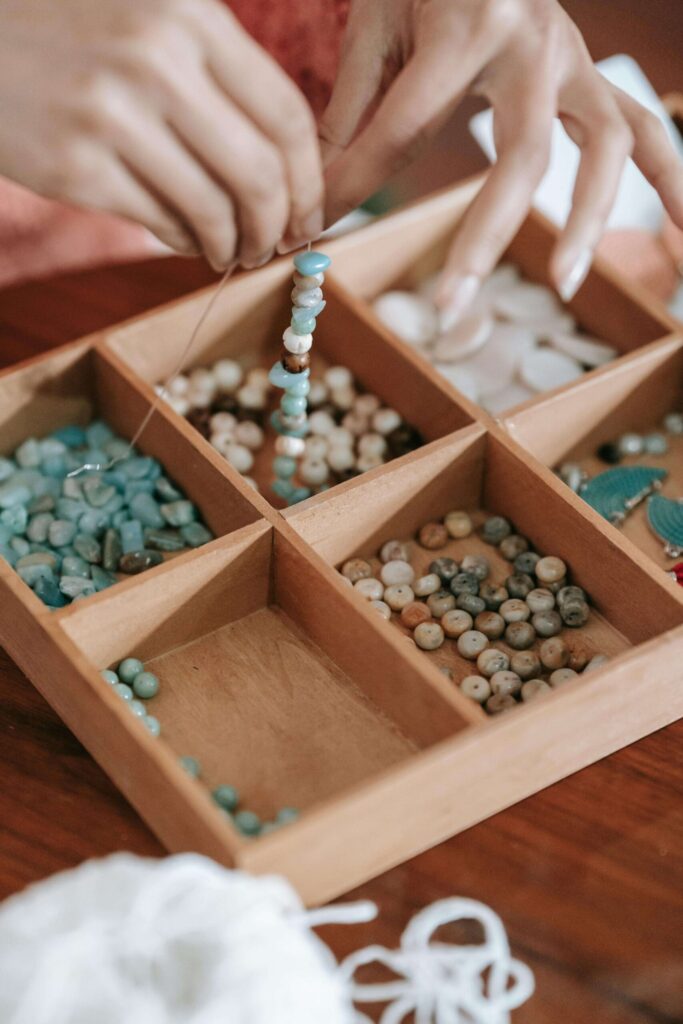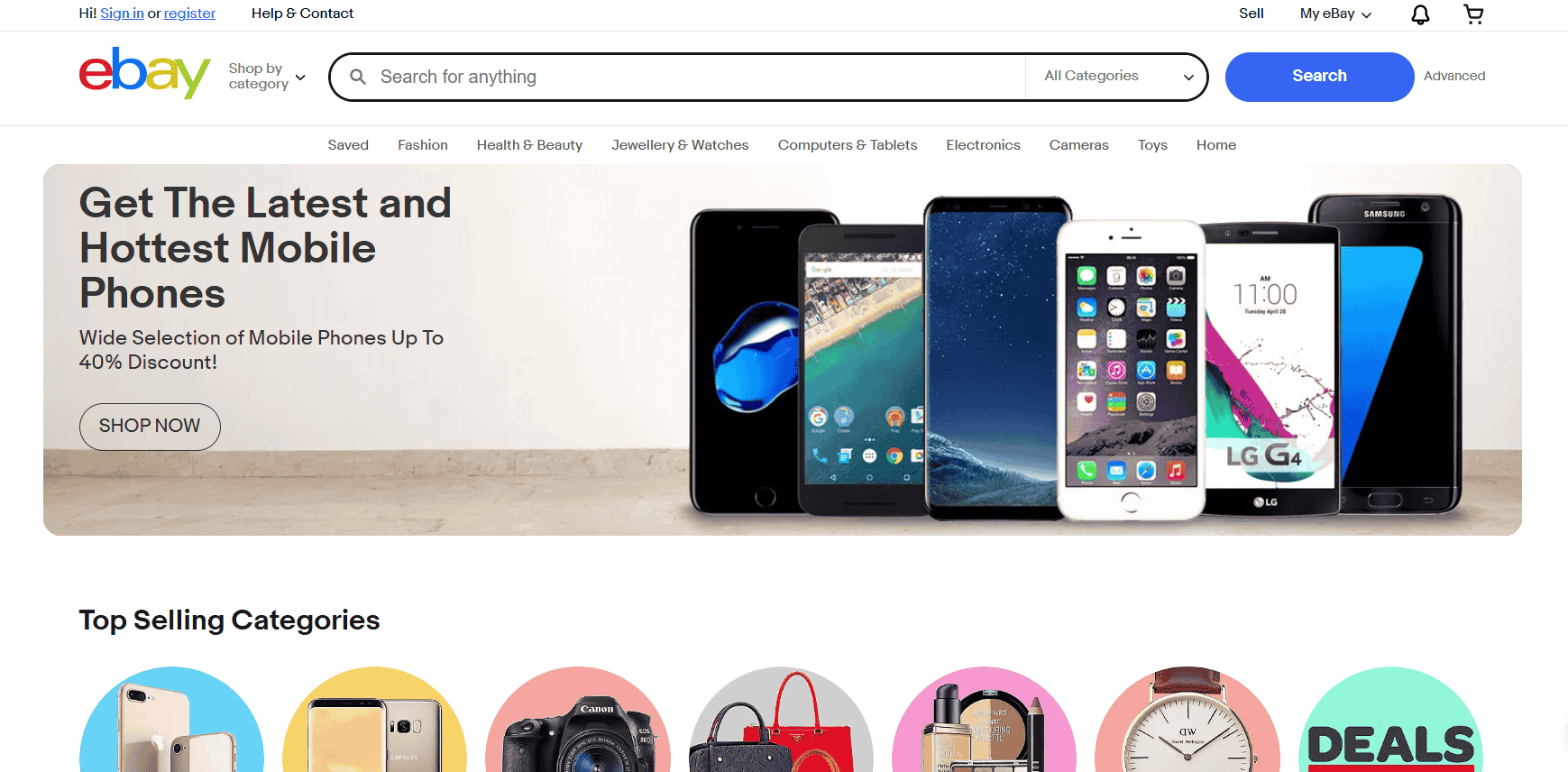Are you serious about turning your handmade jewelry into a thriving online business? The platform you choose matters more than you might think. It’s where you will build a brand, set the tone for customer experience, and decide how far your reach will go.
And in 2025, with buyers craving uniqueness, story, and craftsmanship more than ever, there’s real money on the table. The handmade jewelry market in the US has grown fast, with Statista reporting its value to be around $63 billion in 2023.
What’s driving that growth? Consumers want more than sparkle. They want pieces with soul. That’s where handmade jewelry comes in, and that’s where your opportunity lives.
-
Choosing the right platform can make a big difference in your handmade jewelry sales and brand growth.
-
Etsy is ideal for beginners thanks to its built-in audience and easy setup for handmade products.
-
Shopify gives you full control over your brand and customer experience but requires you to drive your own traffic.
-
Platforms like Amazon Handmade and GoImagine help you reach unique audiences who value handmade craftsmanship and mission-driven shopping.
-
Starting with one platform and expanding to others as your business grows can help you scale strategically and sustainably.
That being said, not all platforms support handmade sellers the same way. Some are perfect for beginners testing the waters. Others are built for scaling a brand and building a loyal fanbase.
I’ve helped everyone from first-time sellers to seasoned pros figure out where to plant their flag, and one pattern keeps repeating—those who choose wisely move faster and earn more.
In this post, we will talk about the 10 best platforms to sell handmade jewelry online in 2025, along with the pros, fees, and real-world tips to help you choose the one that fits your vision.
Why Choosing the Right Platform Matters
When you sell jewelry, you sell craftsmanship, story, and personal style. And that kind of value needs the right stage. A buyer scrolling for factory-made fast fashion won’t blink twice at your listing.
But the person looking for a hand-hammered silver cuff or a gemstone ring wrapped with intention? That’s your audience. And they’re not just shopping. They’re connecting.
These buyers want to know who made the piece, where it came from, and what makes it different from everything else on the market. That means the platform you choose has to do more than host your products. It has to support what makes your work worth buying.
You need a platform where:
- Shoppers care about handmade goods and actually search for them
- You can stand out without spending a fortune on ads
- The fees make sense for your margins, especially if you’re handcrafting every item
- Your store feels like a reflection of your brand, not just another seller in a massive directory
When I help clients pick the right place to sell, I always look at more than just features. I look at the vibe, the values, the tools, and the community. The platforms below were selected with all of that in mind, plus reach, seller tools, and the kind of buyer experience that builds trust and loyalty.
1. Etsy

Etsy is still the king of handmade marketplaces in 2025, and that crown isn’t slipping anytime soon. With over 96 million active buyers and a reputation built on supporting creators, it remains the go-to platform for shoppers who are intentionally looking for custom, handmade, or one-of-a-kind items.
When people type “handmade jewelry” into Google, chances are they’re clicking an Etsy link. That kind of brand power is hard to ignore.
One of Etsy’s biggest advantages is its built-in audience. You’re stepping into a marketplace where customers already care about handmade goods and are often searching with high intent to buy.
Listings are SEO-friendly, meaning you can show up in both Etsy search and Google results, especially if your product titles and tags are well-optimized. The platform also offers niche categories, like birthstone rings or boho bridal earrings, that help your jewelry get discovered faster.
On top of that, setting up a shop is refreshingly easy, even if you have zero technical experience. You can go from signup to live listings in an afternoon.
However, Etsy does come with a few downsides. The biggest one is competition. Some categories are heavily saturated, and standing out might require extra effort in photography, copywriting, and customer engagement.
There are also fees to factor in: Etsy charges a 6.5% transaction fee, $0.20 per listing, and a potential cut for offsite ads if a sale results from an external promotion run by Etsy.
If you’re just getting started or testing your jewelry brand, Etsy is a solid first step. It lets you validate your products, gather social proof through reviews, and build momentum before investing in your own website.
One of my clients launched her crystal wire-wrap jewelry on Etsy in late 2023. She didn’t have a massive Instagram following or any ad spend, just clean product photos, thoughtful descriptions, and a consistent posting schedule.
Within six months, she was bringing in steady sales and earning hundreds of positive reviews, all powered by Etsy’s organic traffic.
2. Shopify
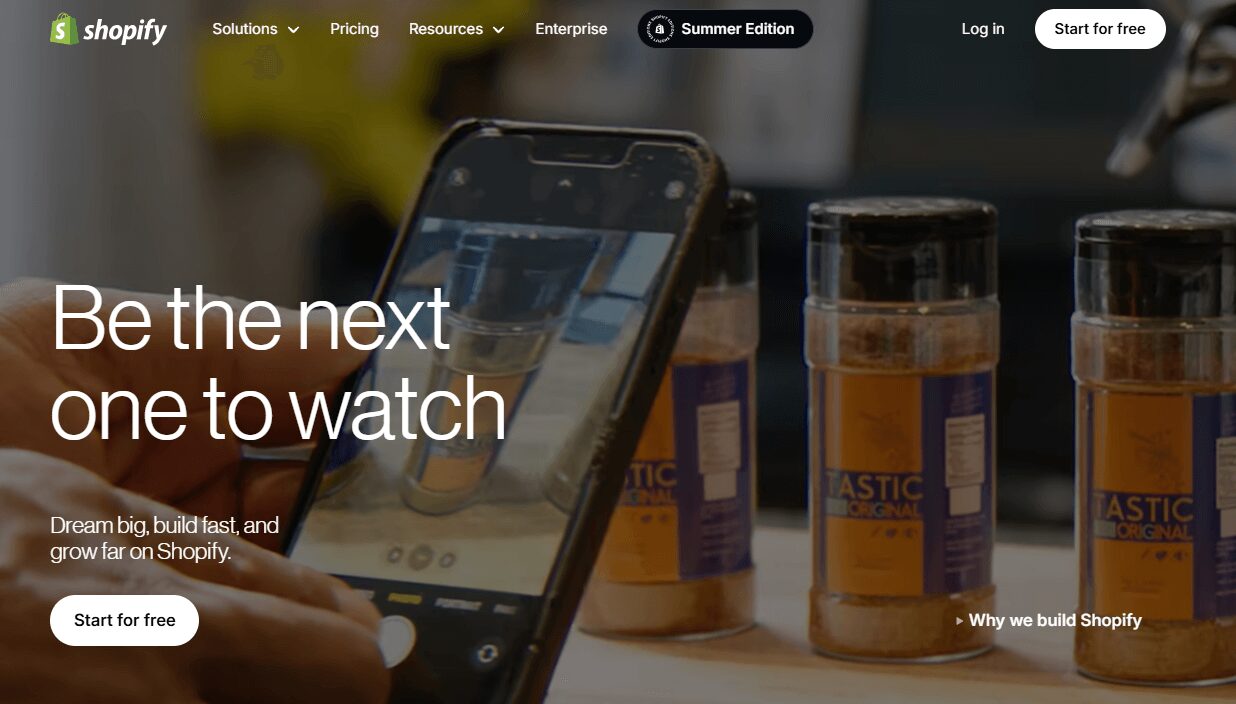
Shopify gives you full control over your brand. Think of it as building your own jewelry boutique online, designed your way, with your voice, your branding, and no marketplace rules dictating how you showcase your products.
There’s no algorithm deciding who sees your listings. You call the shots. With this platform, you can create a fully customizable storefront under your own domain name, which gives your brand a more professional, trustworthy feel.
You also get access to powerful ecommerce tools like built-in email marketing, abandoned cart recovery, detailed analytics, and hundreds of apps that can automate or enhance everything from upselling to inventory management.
And because it’s your standalone site, you won’t have other sellers popping up next to your product, competing for your buyer’s attention.
Of course, that freedom comes with responsibility. Shopify has monthly fees starting at $39, and there’s no built-in traffic like you’d find on a marketplace.
You’ll need to bring in visitors through SEO, email campaigns, influencer collaborations, or paid ads. But for sellers who are ready to build a brand that stands on its own, it’s worth every cent.
One of my clients made the switch from Etsy to Shopify after hitting $5K in monthly sales. She was tired of losing control over her brand’s look and customer journey. Once she moved to Shopify, she started running targeted Instagram ads that directed traffic straight to her new store.
Not only did her site convert better, but her profit margins also doubled because she wasn’t losing fees to third-party ads or marketplace commissions. Shopify gave her the space to scale, and she took full advantage of it.
3. Amazon Handmade
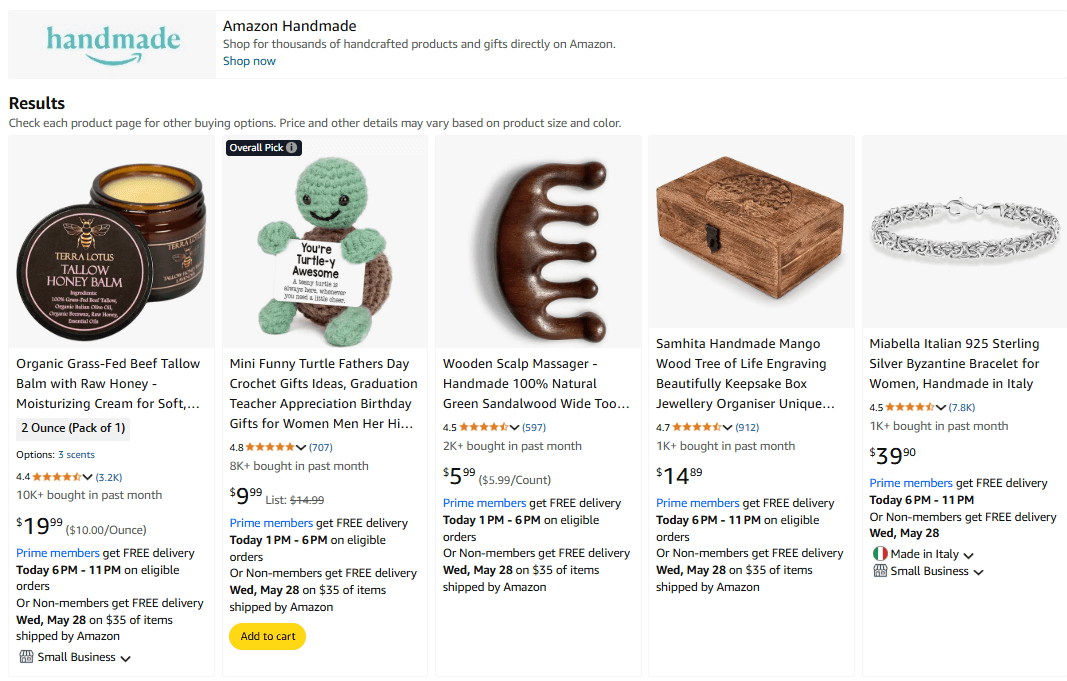
Amazon Handmade offers the reach of Amazon with a curated section built specifically for artisans. That alone makes it one of the most attractive platforms for handmade sellers aiming to get their work in front of millions.
While you do need to apply and get approved—Amazon reviews each application to ensure your products are genuinely handmade—the process is straightforward. And once you’re in, you’re part of one of the world’s largest marketplaces, with access to shoppers who are already in buying mode.
One of the biggest advantages is Amazon’s built-in trust. Customers are comfortable shopping there. Many already have accounts, and because your listings are eligible for Prime shipping, that adds a layer of convenience that shoppers love.
Plus, your products live in a dedicated Handmade section, which means you’re not buried among mass-produced jewelry from overseas. That extra visibility can go a long way.
That said, there are a few things to keep in mind. Amazon charges a 15% referral fee on each sale, which can add up quickly if your margins are thin.
And unlike platforms like Shopify, you have less freedom when it comes to branding. Your product page will follow Amazon’s structure, and there’s limited space for visual storytelling or custom layouts.
Still, if you want to scale volume while keeping your work handmade, Amazon Handmade is worth exploring.
I’ve seen sellers who were doing moderate sales on Etsy suddenly reach new milestones after listing on Amazon Handmade, especially when they paired it with professional product photos and keyword-optimized titles.
Just make sure to track your fees, know your numbers, and price accordingly. The traffic is there, and if your product connects, the orders can start rolling in fast.
4. GoImagine
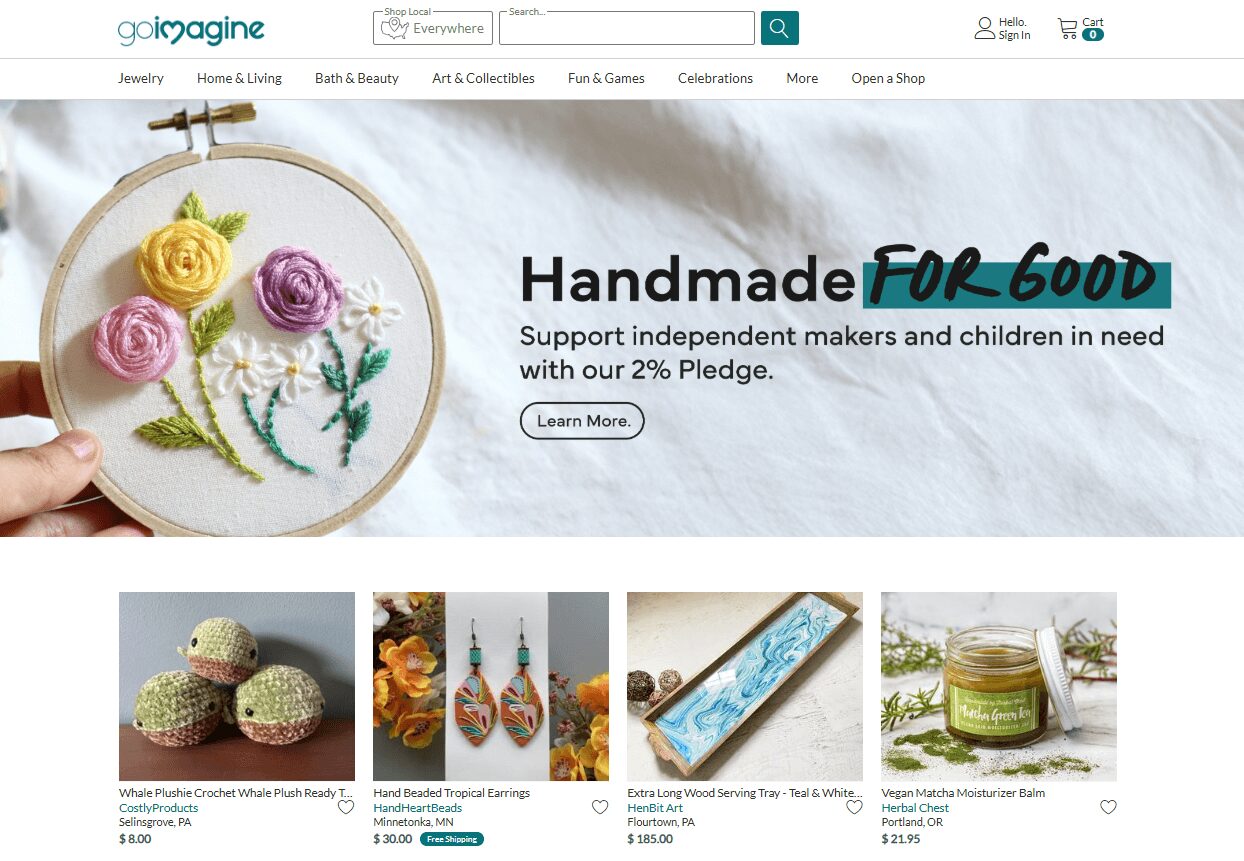
GoImagine is a US-based handmade marketplace with a mission you can feel good about supporting. It’s the only platform of its kind that donates 100% of its profits to children’s charities, including organizations focused on hunger, education, and health.
That mission alone has attracted a unique kind of shopper, one who values where their money goes and is actively looking for handcrafted items with meaning behind them.
What makes GoImagine stand out is that it only allows handmade products. No resellers. No factory-made goods slipping through the cracks. As a seller, you’re part of a curated group of artisans, which helps maintain the integrity of the platform and builds trust with buyers from the start.
The audience may be smaller compared to Etsy or Amazon, but it’s highly targeted. These are people who are already on board with purpose-driven shopping. They’re buying with intention.
And because the platform has low fees, starting at just $2.50 a month, it’s affordable to test the waters or add as a second channel without eating into your profit margins.
I’ve worked with clients who chose GoImagine because they wanted their business to reflect their values. One seller who specializes in eco-friendly gemstone jewelry told me her customers often mentioned the platform’s mission in their messages. That kind of buyer connection creates repeat customers, and that’s worth a lot.
Now, it’s true that GoImagine gets less traffic than giants like Etsy or Amazon Handmade. But what it lacks in volume, it makes up for in loyalty and alignment. If you’re someone who wants to make sales while supporting a bigger cause, this is a platform that fits your brand and your heart.
5. eBay
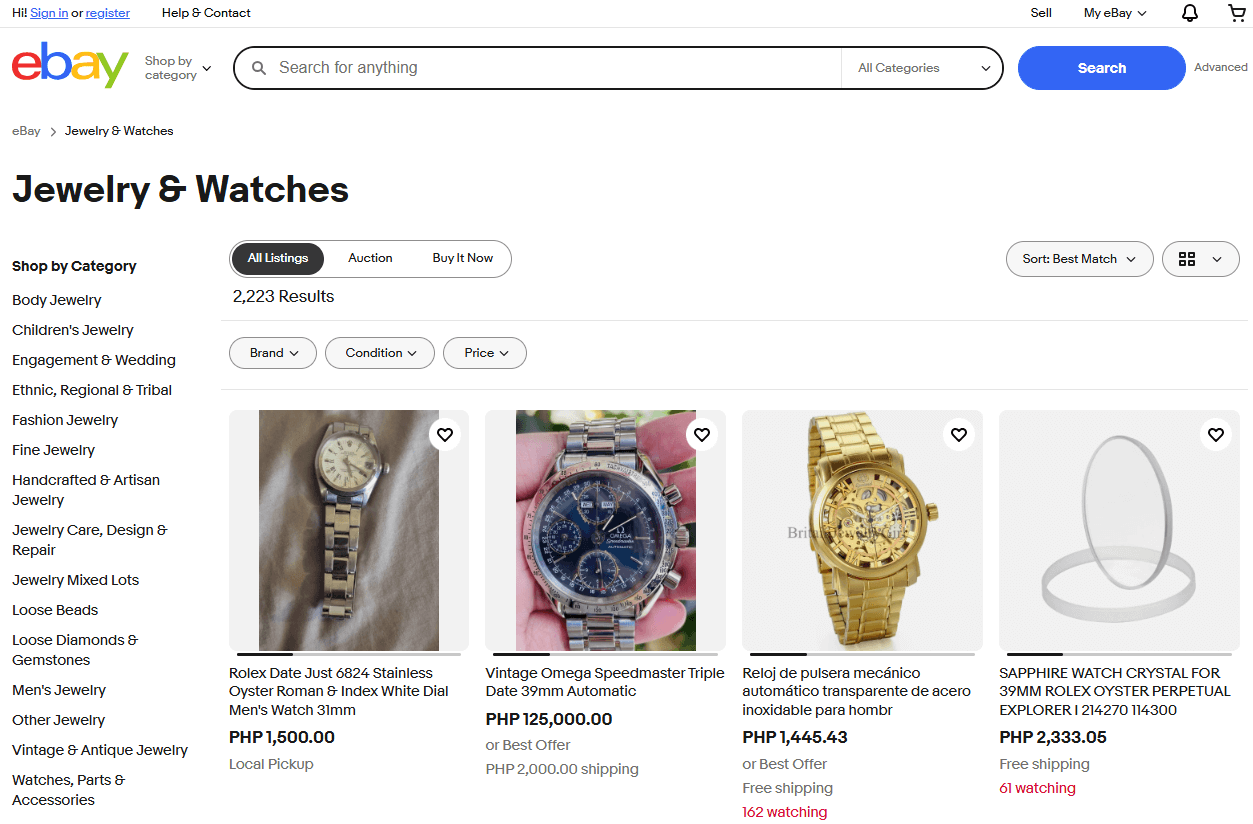
While not handmade-focused, eBay still has a massive, loyal customer base, and it’s surprisingly effective for unique or vintage-inspired jewelry. It might not be the first platform that comes to mind for artisan sellers, but for certain styles and aesthetics, eBay holds its own.
The marketplace has been around since the ’90s, and there’s a reason it’s still relevant: people trust it, use it regularly, and search it for items they can’t easily find anywhere else.
One of eBay’s strengths is built-in traffic. You’re listing your jewelry in front of millions of active buyers who are already comfortable making purchases on the platform.
And if your pieces have a vintage feel, rare stones, or a nostalgic design, like ‘70s boho, ‘90s grunge, or art deco revival, eBay can actually give you an edge.
Auction-style listings are still popular, especially for one-of-a-kind items, and they can push your selling price higher than expected when multiple buyers compete.
That said, eBay isn’t ideal if your goal is luxury handmade branding. The layout is more utilitarian, and while you can add great photos and descriptions, there’s limited space for building a polished brand identity or telling your story visually. If your brand relies heavily on aesthetics and messaging, eBay might feel a little tight.
Still, I’ve seen vintage-style jewelry sellers succeed here, especially those tapping into nostalgia trends. One seller I worked with specialized in antique-look lockets and Victorian-inspired rings.
She found a steady rhythm on eBay, with customers leaving glowing reviews about how her pieces reminded them of heirlooms passed down through generations.
If your jewelry style fits that throwback vibe or you’re experimenting with limited runs of statement pieces, eBay can be a surprisingly strong niche channel.
6. Big Cartel
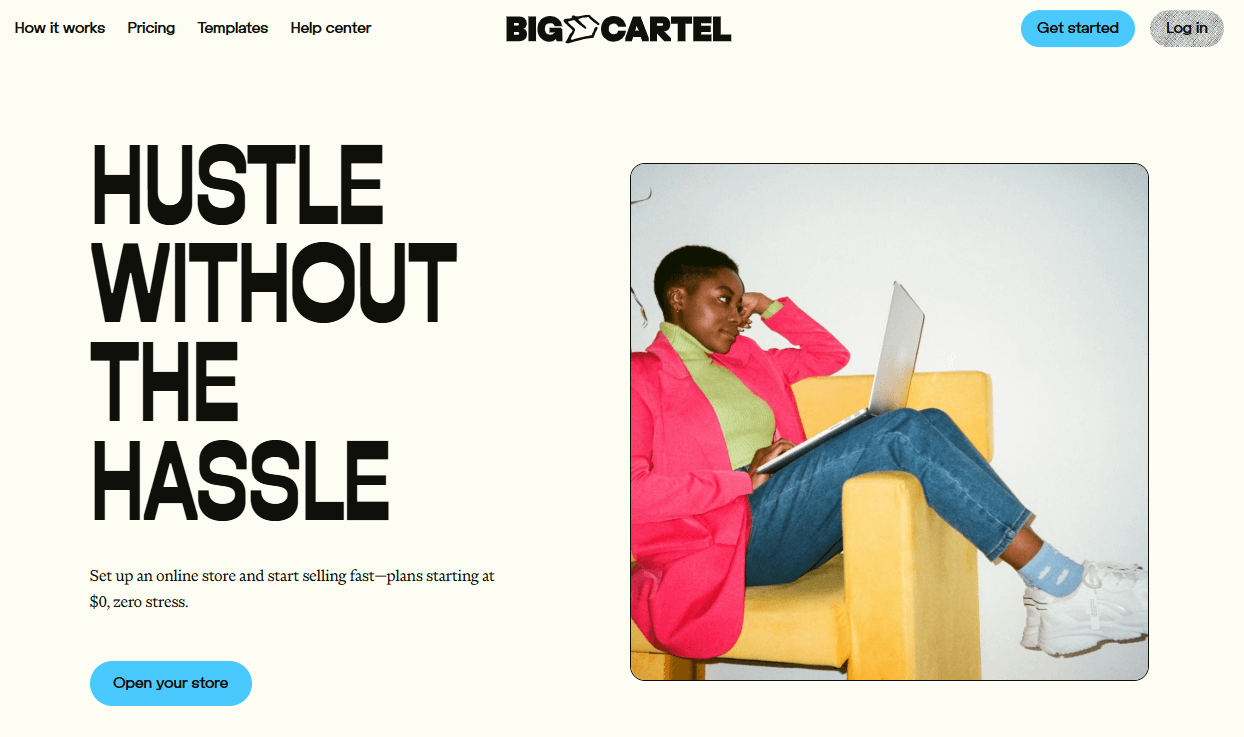
Big Cartel is a simple platform built with indie artists in mind. It’s the kind of space that feels like a digital art fair—clean, uncluttered, and focused on the work. If you’re running a small collection with fewer than 50 products, it’s a comfortable fit that won’t overwhelm you with tech or fees.
One of the best things about Big Cartel is its free plan, which lets you list up to 5 products at no cost. That’s ideal if you’re starting small, testing a new style, or offering a limited capsule collection.
The learning curve is minimal, so you won’t need to spend hours watching tutorials or tweaking code. You can get your store up and running fast, even if this is your first time building an online shop.
The store layouts are artsy and minimal, which works really well for showcasing jewelry with strong design elements, especially if you want your pieces to speak for themselves. There’s something refreshing about a store that isn’t cluttered with upsells or popups. Big Cartel gives your work room to breathe.
On the flip side, Big Cartel is not designed for scaling. If you plan to grow your inventory or need advanced features like complex shipping rules, deep analytics, or marketing automation, you’ll eventually hit some limits.
The platform also has fewer integrations compared to Shopify or WooCommerce, so things like syncing with email tools or running promotions across multiple channels take more effort.
Still, Big Cartel is a great choice if you want a minimalist store without ongoing costs. One of my clients used it to launch a small line of polymer clay earrings. She wasn’t ready for a full-scale store yet, but she wanted a space to point people from her Instagram and craft fair customers.
The clean design made her products pop, and the simplicity let her focus more on creating than managing tech. It was the right fit for where she was, and it helped her build enough traction to eventually graduate to a bigger platform.
7. Facebook Shops & Instagram Shopping
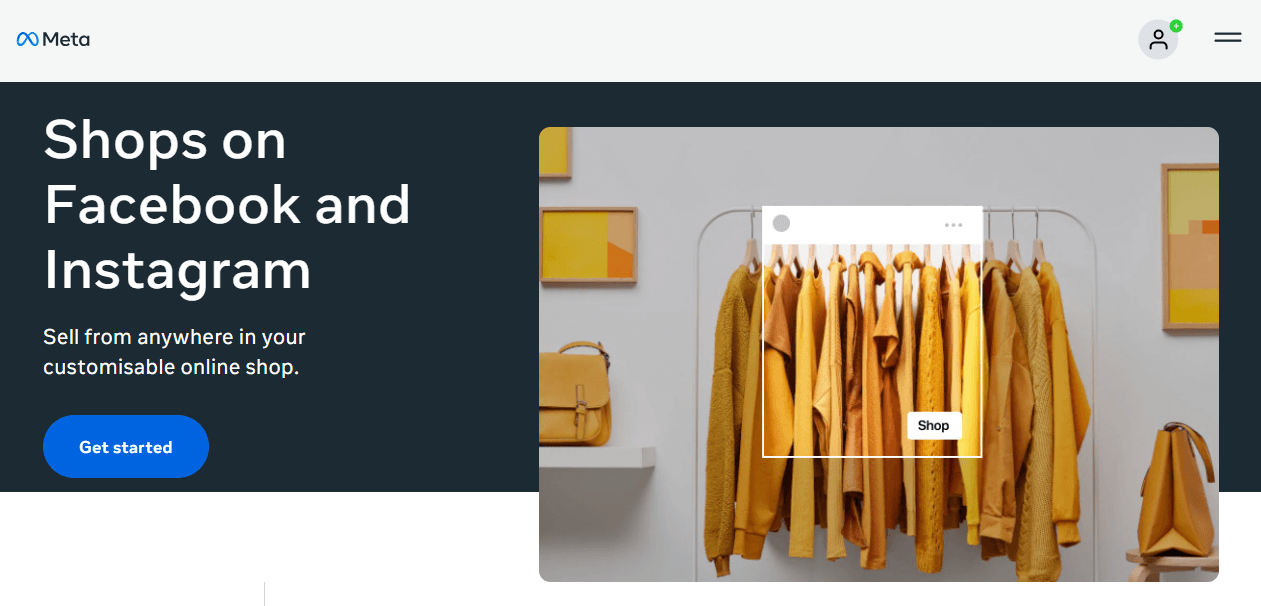
If you already have followers or want to build a direct relationship with your audience, social commerce is a powerful strategy. And in 2025, it’s become a standard part of how handmade jewelry sellers grow.
Facebook Shops and Instagram Shopping give you tools to sell where your customers are already spending time, scrolling through posts, watching Stories, and saving things they love.
Setting up a shop is free, and once your catalog is linked, you can tag products directly in your posts, Reels, and even your Stories. That means if someone sees a necklace they love in your video, they can tap and buy without leaving the app.
For jewelry sellers, this is a huge advantage. Your pieces are visual. Shiny, textured, colorful—exactly the kind of content that performs well on social media. When people see how a pair of earrings move, or how a gemstone catches light, they’re far more likely to take action.
Now, social selling isn’t passive. You’ll need to show up. These platforms reward engagement—posting consistently, replying to comments, answering DMs, and keeping your content fresh. But the flip side is connection. You’re not just listing products. You’re showing the story behind them in real time.
I had a client who leaned into this fully. She started posting short videos of herself crafting her rings, from melting the silver to polishing the final piece. Then she wore her designs in natural lighting and talked to the camera like she was chatting with a friend. Within three months, she doubled her sales.
What made the difference was trust. People felt like they knew her, and they saw the care in every piece. That’s the kind of traction Facebook Shops and Instagram Shopping can unlock when you’re willing to show up consistently and let your audience in.
8. Bonanza
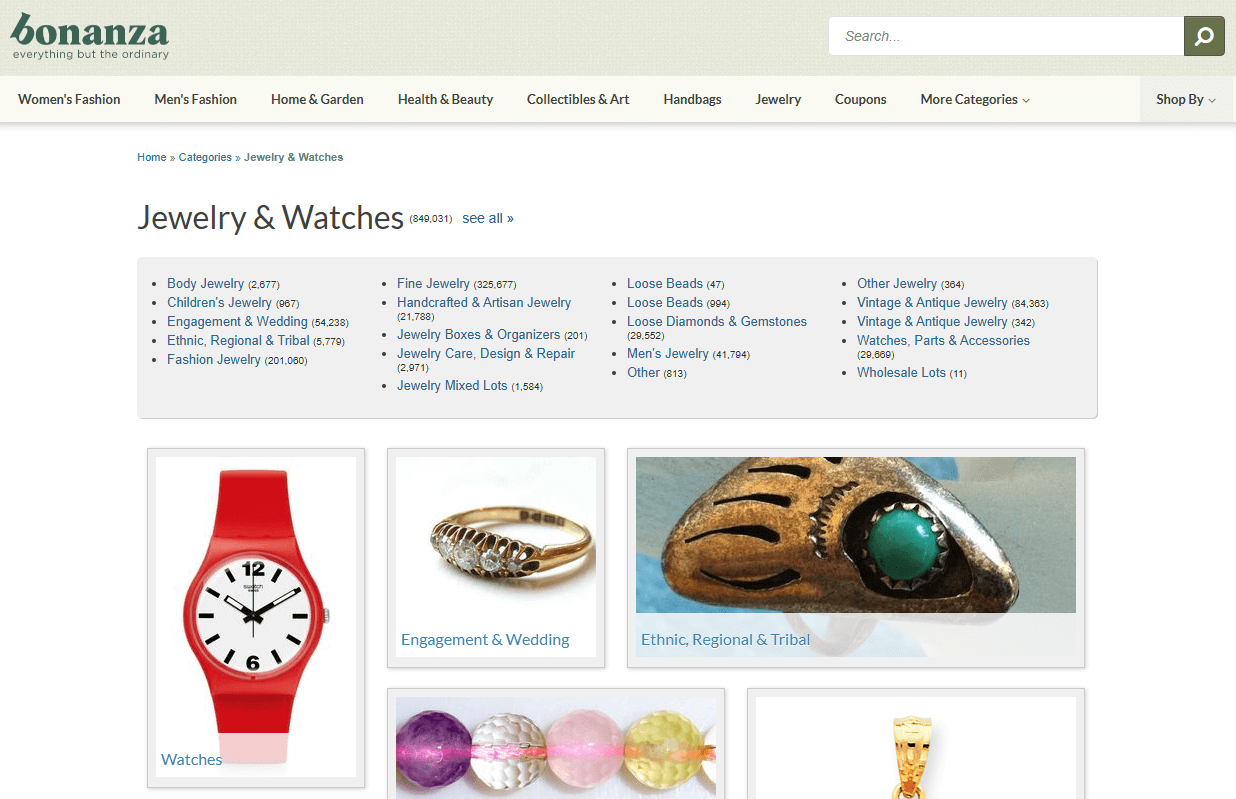
Bonanza flies under the radar, but it’s a seller-friendly platform that can quietly support your growth, especially if you’re looking for ways to diversify your reach without taking on a whole new storefront from scratch. One of its most convenient features is the ability to import Etsy listings easily.
If you’ve already done the work of writing product descriptions, uploading photos, and setting prices on Etsy, you can bring that content over in a few clicks. It also allows imports from eBay, making it a handy hub for multi-platform sellers.
Bonanza keeps things simple and affordable. The platform has low fees, which helps protect your margins, something every handmade jewelry seller should watch closely.
It also integrates with Google Shopping, which means your products can appear in Google search results without you having to manually set up Google Ads or Merchant Center campaigns. That kind of passive reach can drive traffic over time without constant effort.
Now, Bonanza does have lower traffic compared to the major marketplaces like Etsy, Amazon Handmade, or even Facebook Shops. You won’t get a flood of visitors just by listing. But that’s exactly why it works well as a supplement. It’s low-maintenance, and you’re not relying on it as your primary source of sales.
I’ve worked with sellers who use Bonanza as a quiet second or third stream, more like a bonus channel than a main storefront. One seller I helped imported her entire Etsy shop, connected her products to Google Shopping through Bonanza’s tools, and ended up making a few extra sales each month without doing any extra marketing.
It wasn’t her biggest sales driver, but it added income and visibility without extra hassle. If you’re already selling elsewhere and want to widen your footprint without doubling your workload, Bonanza is a solid move.
How to Choose the Right Platform for You
Choosing the right platform to sell your handmade jewelry isn’t a one-size-fits-all decision. It really depends on your goals, your schedule, and where you are in your journey as a maker. Before you jump in, ask yourself a few honest questions.
Do you want to build your own brand or tap into an existing audience? Are you willing to learn marketing tools, or would you prefer to focus more on creating? And most importantly, do you have the profit margins to comfortably cover fees, shipping, packaging, and promotions?
If you’re a beginner, platforms like Etsy or Big Cartel can give you a softer launchpad. They’re accessible, budget-friendly, and don’t require a full marketing strategy from day one. You can learn the ropes, build a product line, and see what resonates with your buyers.
On the other hand, if you’re ready for more control over how your store looks, how you communicate with customers, and how you drive traffic, Shopify or Squarespace might suit you better. You’ll have more tools, more flexibility, and room to scale on your terms.
Already building a loyal fan base on Instagram or Facebook? Then it makes sense to meet your audience where they already hang out. Connect a Facebook Shop or enable Instagram Shopping so you can tag your products and turn content into conversions.
And if you’re at a point where you’re producing at higher volumes and thinking long-term growth, platforms like Amazon Handmade or Faire can open doors to larger audiences or wholesale buyers.
If I had to choose just one platform, I’d say Shopify because you control everything: pricing, branding, emails, traffic, and customer experience. You’re not at the mercy of algorithm changes or competitors stealing your thunder.
One of my clients followed a smart dual approach. She used Etsy to drive her initial sales and gain reviews, while quietly building her Shopify store in the background. Her Etsy traffic gave her momentum, but her Shopify site gave her freedom.
Today, she gets most of her revenue from returning customers who buy directly from her site, people who trust her brand and come back for more.
Selling handmade jewelry online in 2025 is more competitive than ever, but it’s also more full of opportunity. People are actively searching for meaning, story, and quality. You already have all of that. Now you just need to place it on the right digital shelf so the right people can find it.

